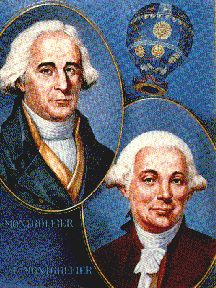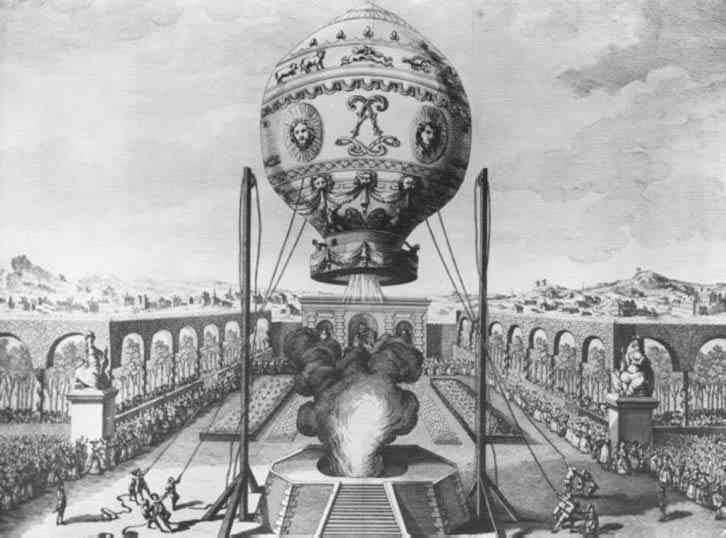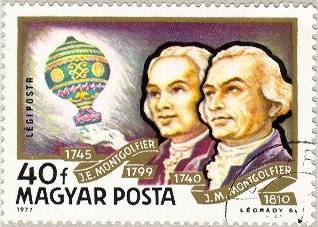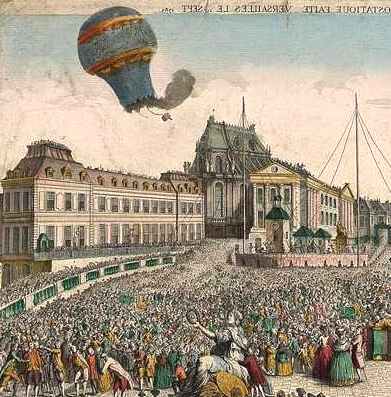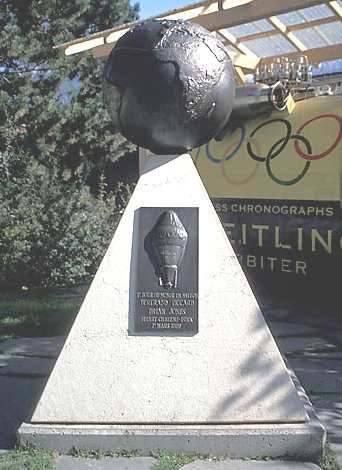|
MONTGOLFIER BROTHERS
|
|
HOME | BIOLOGY | FILMS | GEOGRAPHY | HISTORY | INDEX | INVESTORS | MUSIC | SOLAR BOATS | SPORT |
|
The brothers, Joseph Michel Montgolfier (26 August 1740 – 26 June 1810) and Jacques-Étienne Montgolfier (6 January 1745 – 2 August 1799) were the inventors of the montgolfière, globe airostatique or hot air balloon. The brothers succeeded in launching the first manned ascent to carry a young physician and an audicious army officer into the sky.
In 1782, while watching a fire in his fireplace, Joseph became interested in the "force" that caused the sparks and smoke to rise. He made a small bag out of silk and lit a fire under the opening at the bottom causing it to rise. The brothers thought the burning created a gas which they called "Montgolfier gas". They didn't realize that their balloons rose because the heated air inside was lighter than the surrounding air.
The Montgolfier brothers
Early years
The brothers were born into a family of successful paper manufacturers in Annonay, in the Ardèche, France. Pierre Montgolfier (1700-1793), the father of sixteen children established his eldest son Raymond (1730-1772) as his successor. As a result, the younger sons were initially sent away to school to learn other professions.
Joseph (12th child) possessed a typical inventor's temperament - a maverick and dreamer but impractical in terms of business and personal affairs. Étienne had a much more even and businesslike temperament than Joseph. As the 15th child he was sent to Paris to train as an architect and met there with Jean-Baptiste Réveillon. However, after the sudden and unexpected death of Raymond in 1772, he was recalled to Annonay to run the family business. In the subsequent 10 years, Étienne applied his talent for technical innovation to the family business (papermaking was a high tech industry in the 18th century.) He succeeded in incorporating the latest Dutch innovations of the day into the family mills. His work led to recognition by the government of France as well as the awarding of a government grant to establish the Montgolfier factory as a model for other French papermakers, but also to the family wealth.
Initial experiments
Of the two brothers, it was Joseph who first contemplated building "machines". Gillispie puts it as early as 1777 when Joseph observed laundry drying over a fire incidentally form pockets that billowed upwards. Joseph made his first definitive experiments in November of 1782 while living in Avignon. He reported, some years later, that he was watching a fire one evening while contemplating one of the great military issues of the day - an assault on the fortress of Gibraltar, which had proved impregnable by both sea and land. Joseph mused on the possibility of an air assault using troops lifted by the same force that was lifting the embers from the fire. He believed that contained within the smoke was a special gas, called 'Montgolfier Gas', with a special property he called 'levity'.
As a result of these musings, Joseph set about building a box-like chamber 1x1x1,3m (3 ft by 3 ft by 4 ft) out of very thin wood and covering the sides and top with lightweight taffeta cloth. Under the bottom of the box he crumpled and lit some paper. The contraption quickly lifted off its stand and collided with the ceiling. Joseph then recruited his brother to balloon building by writing the prophetic words: "Get in a supply of taffeta and of cordage, quickly, and you will see one of the most astonishing sights in the world."
Montgolfier brothers balloon Paris 1983
At that time the Montgolfiers did not fully understand the physical basics of the lift produced by the air. They thought it was the dense smoke that was responsible for the upward lift, so they produced it from damp straw and chopped wool. Very pleased with the results they then constructed a silk globe which they took to the gardens of Brogieux . After paper was set to fire under the mouth of the globe, it rose approximately 20 metres into the air and descended slowly back. The results of this experiment were handed over to the Science Academy of France, that invited the two brothers to demonstrate their hot air balloon. The launch date was set to June 4th.
The whole town had gathered to see the demonstration, but almost everyone was convinced the experiment was bound to fail. How could a balloon with a diameter of 10 meters go up by burning a little bit of straw? Most of the people present considered the whole project merely as a publicity stunt of the paper manufacturers. However, after stirring up the fire the balloon rose to the respectable height of 300 meters. After a flight of 1 kilometre it slowly descended to earth. People were stunned, not understanding the miracle.
The two brothers then set about building a contraption 3 times larger in scale (27 times larger in volume). The lifting force was so great that they lost control of their craft on its very first test flight on 14 December 1782. The device floated nearly 2 kilometres (about 1.2 mi). It was destroyed after landing by what Etienne later called the "indiscretion" of passers by.
Public demonstrations
Given these initial successes, the brothers decided to make a public demonstration of a balloon in order to establish their claim to its invention. They constructed a globe-shaped balloon of sackcloth with three thin layers of paper inside. The envelope could contain nearly 790 m3 (28,000 cubic feet) of air and weighed 225 kg (500 lb). It was constructed of four pieces (the dome and three lateral bands), and held together by some 1,800 buttons. A reinforcing "fish net" of cord covered the outside of the envelope.
Montgolfier brothers balloon postage stamp
On 4 June 1783, they flew this craft as their first public demonstration at Annonay in front of a group of dignitaries from the Etats particulars. Its flight covered 2 km (1.2 mi), lasted 10 minutes, and had an estimated altitude of 1.600 - 2.000m (5,200 - 6,600 ft). Word of their success quickly reached Paris. Etienne went to the capital to make further demonstrations and to solidify the brothers' claim to the invention of flight. Joseph, given his unkempt appearance and shyness, remained with the family. Etienne was the epithome of sober virtues ... modest in clothes and manner... He was dressed stylishly in black.
In collaboration with the successful wallpaper manufacturer, Jean-Baptiste Réveillon, Etienne constructed a 37,500 cubic foot envelope of taffeta coated with a varnish of alum. The balloon was sky blue and with golden flourishes, signs of the zodiac, suns. The design was the influence of Réveillon, the wallpaper maker. On the 27th of August a hydrogen balloon was launched from the Champs de Mars in Paris by Jacques Charles. Six thousand people paid for a seat. A downpower of rain ended the show. The next test was on the 11th of September from the parc la Folie Titon, close to the house of Réveillon. There was some concern about the effects of flight into the upper atmosphere on living creatures. The king proposed to launch two criminals, but it is most likely that the inventors decided to send animals aloft first.
On 19 September 1783 the Aerostat Réveillon (as Etienne referred to it) was flown with the first living beings in a basket attached to the balloon: a sheep, called Montauciel (Climb-to-the-sky), a duck and a rooster. This demonstration was performed before a huge crowd at the royal palace in Versailles, before King Louis XVI of France, Queen Marie Antoinette.
The flight lasted approximately 8 minutes, covered 2 miles, and obtained an altitude of about 1500 feet. The flight would have been longer but the craft was unstable. It tipped wildly just after launch which allowed a considerable amount of hot air to spill from the mouth. The animals survived the trip unharmed. ...the sheep was discovered nibbling imperturbably on straw while the cock and the duck cowered in a corner.
Human flight
With the successful demonstration at Versailles, and again in collaboration with Réveillon, Etienne started construction of a 60,000 cubic foot balloon for the purpose of making flights with humans. (Etienne's excursion, albeit tethered was the cause of much paternal consternation as he had promised his father that he would not ride in a balloon himself.) The craft was once again decorated with flourishes and was 75 feet tall and 46 feet in diameter.
The balloon was tested in tethered flights later in 1783 on 15 October by Pilâtre de Rozier, a twenty-six-year-old physician, who offered his services. On the 17th the experiment was repeated before a group of scientists and 19 October Rozier and André Giroud de Villette, a wallpaper manufacturer from Madrid, reached 324 foot within 15 seconds along retaining ropes.
On 21 November 1783, the first free flight by humans was made Pilâtre, together with an army officer, the marquis d'Arlandes. They flew aloft for 25 minutes about 100 metres above Paris for a distance of nine kilometres. The flight began near the Bois de Boulogne in the courtyard of the Château de la Muette in the western outskirts of Paris and landed between the windmills on the Butte-aux-Cailles.
Enough fuel remained on board at the end of the flight to have allowed the balloon to fly four to five times as far. However, burning embers from the fire were scorching the balloon fabric and had to be daubed out with sponges. Thus the baloonists decided to land as soon as they were over open countryside.
The ascensions made a sensation. Numerous engravings commemorated the events. Chairs were designed with balloon backs, and mantel clocks were produced in enamel and gilt-bronze replicas set with a dial in the balloon. One could buy crockery decorated with naive pictures of balloons.
Following launches
In 1766, the British scientist Henry Cavendish had discovered hydrogen, by adding sulphuric acid to iron, tin, or zinc shavings. The development of gas balloons proceeded almost in parallel with the work of the Montgolfiers. This work was led by M. Charles. Work on each type of balloon was spurred on by the knowledge that there was a competing group and alternative technology.
For a variety of reasons, including the fact that the French government chose to put a proponent of hydrogen in charge of balloon development, hot air balloons were superseded by hydrogen balloons. Hydrogen balloons became the predominant technology for the next 180 years.
Balloons were used for all major ballooning accomplishments such as the crossing of the English Channel on 7 January 1785, by one of the most tireless astronauts Jean-Pierre Blanchard and Dr. John Jeffries, from Boston.
Montgolfier brothers balloon flight Paris street scene
Competing claims
Some claim that the hot air balloon was actually invented some 74 years earlier by the portuguese priest Bartolomeu de Gusmão. A description of his invention was published in 1709, in Vienna, and another one that was lost was found in the Vatican (circa 1917). However, this claim is not generally recognized by aviation historians outside the Portuguese speaking community, in particular the FAI.
Revival of the hot air balloon
Although balloons employing heated air for lift were used from time to time, the modern revival of the hot air balloon began on 22 October 1960 in Bruning, Nebraska on when Ed Yost improved the safety of the classic Montgolfier design by using a plastic envelope and a kerosene fueled heater.
Today, hot air balloons that use propane fuel and rip-stop nylon envelopes are by far the predominant method for obtaining buoyant flight.
LINKS and REFERENCE
GENERAL HISTORY
MARITIME HISTORY
Breitling Orbiter monument - first global navigation by a hot air balloon
A taste for adventure capitalists
Solar Cola - a healthier alternative
|
|
This
website
is Copyright © 1999 & 2007 NJK. The bird The name '1824' is a trade mark of Solar Cola Ltd. All rights reserved. Max Energy Limited is an educational charity. |
|
AUTOMOTIVE | BLUEBIRD | ELECTRIC CARS | ELECTRIC CYCLES | SOLAR CARS |
